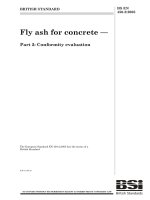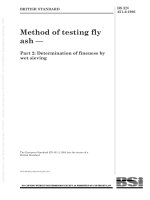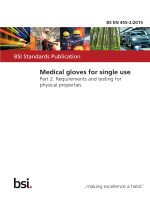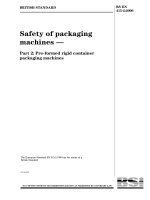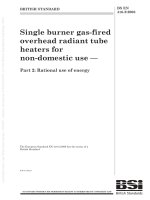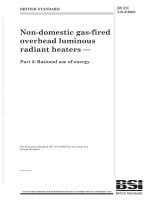Bsi bs en 12004 2 2017
Bạn đang xem bản rút gọn của tài liệu. Xem và tải ngay bản đầy đủ của tài liệu tại đây (2.02 MB, 40 trang )
BS EN 12004-2:2017
BSI Standards Publication
Adhesives for ceramic tiles
Part 2: Test methods
BS EN 12004-2:2017
BRITISH STANDARD
National foreword
This British Standard is the UK implementation of EN 12004-2:2017.
It supersedes BS EN 1308:2007, BS EN 1323:2007, BS EN 1324:2007,
BS EN 1346:2007, BS EN 1348:2007, BS EN 12003:2008 and BS EN
12002:2008 which are withdrawn.
The UK participation in its preparation was entrusted to Technical
Committee B/539, Ceramic tiles and other rigid tiling.
A list of organizations represented on this committee can be
obtained on request to its secretary.
This publication does not purport to include all the necessary
provisions of a contract. Users are responsible for its correct
application.
© The British Standards Institution 2017.
Published by BSI Standards Limited 2017
ISBN 978 0 580 88363 7
ICS 83.180; 91.100.10; 91.100.30
Compliance with a British Standard cannot confer immunity from
legal obligations.
This British Standard was published under the authority of the
Standards Policy and Strategy Committee on 28 February 2017.
Amendments/corrigenda issued since publication
Date
Text affected
BS EN 12004-2:2017
EN 12004-2
EUROPEAN STANDARD
NORME EUROPÉENNE
EUROPÄISCHE NORM
February 2017
ICS 83.180; 91.100.10; 91.100.30
Supersedes EN 12002:2008, EN 12003:2008, EN
1308:2007, EN 1323:2007, EN 1324:2007, EN
1346:2007, EN 1348:2007
English Version
Adhesives for ceramic tiles - Part 2: Test methods
Colles à carrelage - Partie 2 : Méthodes d'essai
Mörtel und Klebstoffe für Fliesen und Platten - Teil 2:
Prüfverfahren
This European Standard was approved by CEN on 15 July 2016.
CEN members are bound to comply with the CEN/CENELEC Internal Regulations which stipulate the conditions for giving this
European Standard the status of a national standard without any alteration. Up-to-date lists and bibliographical references
concerning such national standards may be obtained on application to the CEN-CENELEC Management Centre or to any CEN
member.
This European Standard exists in three official versions (English, French, German). A version in any other language made by
translation under the responsibility of a CEN member into its own language and notified to the CEN-CENELEC Management
Centre has the same status as the official versions.
CEN members are the national standards bodies of Austria, Belgium, Bulgaria, Croatia, Cyprus, Czech Republic, Denmark, Estonia,
Finland, Former Yugoslav Republic of Macedonia, France, Germany, Greece, Hungary, Iceland, Ireland, Italy, Latvia, Lithuania,
Luxembourg, Malta, Netherlands, Norway, Poland, Portugal, Romania, Serbia, Slovakia, Slovenia, Spain, Sweden, Switzerland,
Turkey and United Kingdom.
EUROPEAN COMMITTEE FOR STANDARDIZATION
COMITÉ EUROPÉEN DE NORMALISATION
EUROPÄISCHES KOMITEE FÜR NORMUNG
CEN-CENELEC Management Centre: Avenue Marnix 17, B-1000 Brussels
© 2017 CEN
All rights of exploitation in any form and by any means reserved
worldwide for CEN national Members.
Ref. No. EN 12004-2:2017 E
BS EN 12004-2:2017
EN 12004-2:2017 (E)
Contents
Page
European foreword....................................................................................................................................................... 4
1
Scope .................................................................................................................................................................... 5
2
Normative references .................................................................................................................................... 5
3
Sampling ............................................................................................................................................................. 6
4
Test conditions................................................................................................................................................. 6
5
5.1
5.2
5.3
5.3.1
5.3.2
Test materials ................................................................................................................................................... 6
General ................................................................................................................................................................ 6
Ceramic tiles...................................................................................................................................................... 6
Test substrate ................................................................................................................................................... 6
Concrete slab .................................................................................................................................................... 6
Other substrates .............................................................................................................................................. 6
6
Mixing of the adhesive ................................................................................................................................... 7
7
Test report ......................................................................................................................................................... 7
8
8.1
8.1.1
8.1.2
8.1.3
8.1.4
8.1.5
8.2
8.2.1
8.2.2
8.2.3
8.2.4
8.3
8.3.1
8.3.2
8.3.3
8.3.4
8.3.5
8.4
8.4.1
8.4.2
8.4.3
8.4.4
8.4.5
8.5
8.5.1
8.5.2
8.5.3
8.5.4
8.5.5
8.6
8.6.1
8.6.2
Test methods .................................................................................................................................................... 8
Determination of open time ........................................................................................................................ 8
Test materials ................................................................................................................................................... 8
Apparatus........................................................................................................................................................... 8
Procedure........................................................................................................................................................... 8
Evaluation and expression of results ....................................................................................................... 9
Test report ......................................................................................................................................................... 9
Determination of slip ..................................................................................................................................... 9
Test materials ................................................................................................................................................... 9
Apparatus........................................................................................................................................................... 9
Procedure........................................................................................................................................................ 10
Test report ...................................................................................................................................................... 10
Determination of tensile adhesion strength for cementitious adhesives (C) ........................ 11
Test materials ................................................................................................................................................ 11
Apparatus........................................................................................................................................................ 11
Procedure........................................................................................................................................................ 12
Evaluation and expression of results .................................................................................................... 13
Test report ...................................................................................................................................................... 14
Determination of shear adhesion strength of dispersion adhesives (D) ................................. 14
Test materials ................................................................................................................................................ 14
Apparatus........................................................................................................................................................ 14
Procedure........................................................................................................................................................ 17
Evaluation and expression of results .................................................................................................... 19
Test report ...................................................................................................................................................... 19
Determination of shear adhesion strength of reaction resin adhesives (R) .......................... 19
Test materials ................................................................................................................................................ 19
Apparatus........................................................................................................................................................ 19
Procedure........................................................................................................................................................ 20
Evaluation and expression of results .................................................................................................... 22
Test report ...................................................................................................................................................... 22
Determination of transverse deformation of cementitious adhesives (C).............................. 22
Principle .......................................................................................................................................................... 22
Test materials ................................................................................................................................................ 22
2
BS EN 12004-2:2017
EN 12004-2:2017 (E)
8.6.3
8.6.4
8.6.5
Apparatus ........................................................................................................................................................ 23
Procedure ........................................................................................................................................................ 25
Test report ...................................................................................................................................................... 26
Annex A (normative) Concrete slab for test ..................................................................................................... 27
A.1
General information .................................................................................................................................... 27
A.2
Test conditions .............................................................................................................................................. 27
A.3
Apparatus ........................................................................................................................................................ 27
A.4
Concrete slab .................................................................................................................................................. 27
A.4.1 Manufacture of the concrete slab............................................................................................................ 27
A.4.2 Conditioning of the concrete slab ........................................................................................................... 28
A.4.3 Water absorption at the surface.............................................................................................................. 28
A.4.4 Tensile adhesion strength ......................................................................................................................... 28
A.4.5 Data recorded ................................................................................................................................................ 28
Annex B (normative) Failure patterns ............................................................................................................... 31
B.1
Adhesion failure (AF-S or AF-T) .............................................................................................................. 31
B.2
Cohesive failure within the adhesive (CF-A) ....................................................................................... 32
B.3
Cohesive failure in the substrate or in the tile (CF-S or CF-T) ...................................................... 33
Bibliography ................................................................................................................................................................. 35
3
BS EN 12004-2:2017
EN 12004-2:2017 (E)
European foreword
This document (EN 12004-2:2017) has been prepared by Technical Committee CEN/TC 67 “Ceramic
tiles”, the secretariat of which is held by UNI.
This European Standard shall be given the status of a national standard, either by publication of an
identical text or by endorsement, at the latest by August 2017, and conflicting national standards shall
be withdrawn at the latest by August 2017.
Attention is drawn to the possibility that some of the elements of this document may be the subject of
patent rights. CEN shall not be held responsible for identifying any or all such patent rights.
This document supersedes EN 1308:2007,
EN 1348:2007, EN 12002:2008, EN 12003:2008.
EN 1323:2007,
EN 1324:2007,
EN 1346:2007,
EN 12004, Adhesives for tiles, is composed with the following parts:
— Part 1: Requirements, evaluation of conformity, classification and designation;
— Part 2: Test methods.
According to the CEN-CENELEC Internal Regulations, the national standards organisations of the
following countries are bound to implement this European Standard: Austria, Belgium, Bulgaria,
Croatia, Cyprus, Czech Republic, Denmark, Estonia, Finland, Former Yugoslav Republic of Macedonia,
France, Germany, Greece, Hungary, Iceland, Ireland, Italy, Latvia, Lithuania, Luxembourg, Malta,
Netherlands, Norway, Poland, Portugal, Romania, Serbia, Slovakia, Slovenia, Spain, Sweden, Switzerland,
Turkey and the United Kingdom.
4
BS EN 12004-2:2017
EN 12004-2:2017 (E)
1 Scope
This European Standard specifies the methods for determining characteristics for adhesives used in
internal and external installation of ceramic tiles.
This European Standard does not contain performance requirements or recommendations for the
design and installation of ceramic tiles.
The following test methods are described:
— determination of open time (8.1);
— determination of slip (8.2);
— determination of tensile adhesion strength for cementitious adhesives (8.3);
— determination of shear adhesion strength of dispersion adhesives (8.4);
— determination of shear adhesion strength of reaction resin adhesives (8.5);
— determination of transverse deformation of cementitious adhesives (8.6).
NOTE
Ceramic tile adhesives can be used also for other kinds of tiles (natural and agglomerated stones, etc.),
if they do not adversely affect the stones.
WARNING — This European Standard can involve hazardous materials and operations. Persons
using this standard should be familiar with normal laboratory practice. This European Standard
does not purport to address all the safety problems, if any, associated with its use. It is the
responsibility of the user to establish appropriate safety and health practices and to ensure
compliance with any European and national regulatory conditions.
2 Normative references
The following documents, in whole or in part, are normatively referenced in this document and are
indispensable for its application. For dated references, only the edition cited applies. For undated
references, the latest edition of the referenced document (including any amendments) applies.
EN 196-1:2016, Methods of testing cement — Part 1: Determination of strength
EN 459-2, Building lime - Part 2: Test methods
EN 1067, Adhesives - Examination and preparation of samples for testing
EN 12004-1, Adhesives for ceramic tiles - Part 1: Requirements, assessment and verification of constancy
of performance, classification and marking
EN 14411, Ceramic tiles - Definition, classification, characteristics, assessment and verification of
constancy of performance and marking
EN ISO 15605, Adhesives - Sampling (ISO 15605)
5
BS EN 12004-2:2017
EN 12004-2:2017 (E)
3 Sampling
Take at least 2 kg sample of the adhesive in accordance with EN ISO 15605 and EN 1067.
4 Test conditions
Standard conditions shall be (23 ± 2) °C and (50 ± 5) % relative humidity and the speed of air in the
testing area less than 0,2 m/s.
The tolerance in the time of conditioning for all test specimens shall be as shown in Table 1 below:
Table 1 — Allowed tolerance in testing time for all samples requiring conditioning
Sample Conditioning Time
Allowed tolerance for testing
6h
±15 min
21 d
±9 h
7d
14 d
28 d
Testing shall be performed within the specified time window.
±3 h
±6 h
±12 h
5 Test materials
5.1 General
Condition all test materials for at least 24 h under standard conditions.
The adhesive to be tested shall be within its shelf life, where this is specified.
5.2 Ceramic tiles
The tiles shall be checked prior to conditioning to ensure that they are unused, clean and dry.
The type of tile shall be as specified under the specific test procedures found in Clause 8.
5.3 Test substrate
5.3.1 Concrete slab
The concrete slab shall be at least 35 mm thick, have a moisture content of less than 3 % by mass
(carbide method) and have a water absorption at the surface after 4 h in the range of 0,5 cm3 to 1,5 cm3.
The tensile adhesion strength shall be at least 1,5 N/mm2.
The test surface shall have a finish similar to that obtained by using a wooden float and be clean and
dust-free at the time of the test.
A method for manufacturing a suitable concrete test slab and the procedures for measuring the
performances are given in Annex A.
5.3.2 Other substrates
Other substrates may be used upon agreement if the substrate is recommended for ceramic tile
application by the adhesive manufacturer. To demonstrate compatibility with other optional substrates,
the adhesive shall be applied to the selected substrate in accordance with the open time test method
(8.1). When the result of > 0,5 N/mm2 is achieved or cohesive failure occurs in the substrate, the
requirement is considered satisfied.
6
BS EN 12004-2:2017
EN 12004-2:2017 (E)
6 Mixing of the adhesive
The amount of water and/or liquid admix required for preparing the cementitious adhesive shall be as
stated by the manufacturer in parts by mass, i.e. liquid to dry powder (in the case where a range of
values is given, the average shall be used).
Prepare a minimum quantity of 2 kg of the adhesive in a mixer of the type described in EN 196-1:2016,
4.4, using the slow speed settings (140 ± 5) rotations per min and (62 ± 5) revolution planetary
movement.
Carry out the following procedure:
— pour the liquid into the pan;
— scatter the dry powder over the liquid;
— mix for 30 s;
— take out the mixing paddle;
— scrape down the paddle and pan within 1 min;
— replace the paddle and mix for 1 min.
Let the adhesive mature as specified in the manufacturer's instructions, and then mix for a further 15 s.
Where ready-to-use dispersion adhesives or reaction resin adhesives are to be used, the manufacturer's
instructions shall be followed.
7 Test report
The test report shall provide the following information:
a) the number and year of issue of this European Standard, i.e. EN 12004-2, and date of issue;
b) the place, date and time of sampling;
c) type of adhesive, commercial designation and manufacturer;
d) identification of test sample;
e) handling and storage of samples before testing;
f)
test conditions;
g) date of test;
h) amount of water or liquid used for preparing the adhesive (for cementitious adhesives);
i)
j)
any other factor that could have influenced the result;
test results (individual and mean values and mode of failure where required):
1) open time;
2) slip;
7
BS EN 12004-2:2017
EN 12004-2:2017 (E)
3) tensile adhesion strength;
4) shear adhesion strength;
5) transverse deformation.
8 Test methods
8.1 Determination of open time
8.1.1 Test materials
8.1.1.1 Ceramic tiles
The tiles used for this method shall be glazed porous body tile complying with EN 14411, group BIII, of
water absorption (15 ± 3) % by mass, with a thickness in the range 7 mm to 10 mm and a profile back
pattern less than 0,25 mm deep, cut to facial dimensions of (50 ± 1) mm x (50 ± 1) mm.
8.1.1.2 Test substrate
The concrete slab shall comply with the requirements given in 5.3.1.
8.1.2 Apparatus
8.1.2.1
Notched trowel.
A notched trowel having 6 mm x 6 mm notches at 12 mm centres.
8.1.2.2
Weight (Mass).
A mass capable of exerting a force of (20 ± 0,05) N, with a cross-sectional area of less than
50 mm x 50 mm.
8.1.2.3
Pull-head plates.
Square metallic plates, with dimensions of (50 ± 1) mm x (50 ± 1) mm and a minimum thickness of
10 mm with a suitable fitting for connection to the test machine.
8.1.2.4
Test machine.
A test machine for direct pull tensile force test and with suitable capacity and sensitivity for the test.
The machine shall be capable of applying the load to the pull-head plate at the rate of (250 ± 50) N/s
through a suitable fitting that does not exert any bending force.
8.1.3 Procedure
Apply a thin layer of the adhesive, mixed in accordance with Clause 6, to the concrete slab with a
straight edge trowel. Then apply a thicker layer and comb with the notched trowel (8.1.2.1).
The trowel shall be held at an angle of approximately 60° to the substrate at a right angle to one edge of
the slab and drawn across the slab parallel to that edge (in a straight line).
After 5 min, 10 min, 20 min and 30 min place at least 10 test tiles (8.1.1.1) 50 mm apart, on the adhesive
within 30 s. The tiles are placed on no more than four ribs for all adhesives. Load each tile with
(20 ± 0,05) N for 30 s (8.1.2.2).
After 27 d storage under standard conditions, bond the pull-head plates (8.1.2.3) to the tiles with a
suitable high strength adhesive (e.g. epoxide adhesive).
After a further 24 h storage under standard conditions determine the tensile adhesion strength of the
adhesive by applying a force increasing at a constant rate of (250 ± 50) N/s.
8
BS EN 12004-2:2017
EN 12004-2:2017 (E)
8.1.4 Evaluation and expression of results
The individual tensile adhesion strengths are quoted to the nearest 0,1 N/mm2 using the following
formula:
As = L A
where
(1)
As is the individual tensile adhesion strength in Newton per square millimetre;
L
A
is the total tensile load in Newton;
is the bonding area in square millimetre (2 500 mm2).
The tensile adhesion strength for each time interval is determined as follows:
— determine the mean of the 10 values;
— discard the values falling outside the range of ± 20 % of the mean value;
— if five or more values remain, determine the new mean;
— if less than five values remain repeat the test;
— determine the mode of failure of the test units according to Annex B as the predominant mode.
The open time in minutes, is the maximum time interval at which the adhesive meets the tensile
adhesion strength requirement defined in EN 12004-1.
8.1.5 Test report
The information listed in Clause 7, items a) to i) shall be provided plus item j) 1: open time in minutes.
8.2 Determination of slip
8.2.1 Test materials
8.2.1.1 Ceramic tiles
The tiles used for this method shall be dry pressed ceramic tile in accordance with EN 14411, group BIa,
with a water absorption ≤ 0,5 % by mass, unglazed, with plane adhering surface and with facial
dimensions of (100 ± 1) mm x (100 ± 1) mm, a mass of (200 ± 10) g and a thickness in the range of
8 mm to 10 mm.
8.2.1.2 Test substrate
The concrete slab shall comply with the requirements given in 5.3.1.
8.2.2 Apparatus
8.2.2.1
Steel straight edge.
8.2.2.2
Clamps.
9
BS EN 12004-2:2017
EN 12004-2:2017 (E)
8.2.2.3
Masking tape.
A 25 mm wide masking tape.
8.2.2.4
Notched trowel.
A notched trowel having 6 mm x 6 mm notches at 12 mm centres.
8.2.2.5
Spacers.
Two (25 ± 0,5) mm x (25 ± 0,5) mm x (10 ± 0,5) mm thick spacers made from stainless steel.
8.2.2.6
Weight (Mass).
A mass capable of exerting a force of (50 ± 0,1) N with a cross-sectional area of less than
(100 ± 1) mm x (100 ± 1) mm.
8.2.2.7
Vernier caliper.
A Vernier caliper accurate to 0,01 mm.
8.2.3 Procedure
Secure the steel straight edge (8.2.2.1), with the clamps (8.2.2.2), at the top of the concrete slab so that
its bottom edge is horizontal when the slab is raised to its vertical position.
Position 25 mm wide masking tape (8.2.2.3) immediately below the steel straight edge and apply a thin
layer of the adhesive mixed in accordance with Clause 6 to the concrete slab with a straight edge trowel.
Then apply a thicker layer of adhesive to the surface of the concrete slab so that it just overlaps the
bottom edge of the masking tape. Comb the adhesive at right angles to the straight-edge with the
notched trowel (8.2.2.4).
The trowel shall be held at an angle of approximately 60° to the substrate and parallel to the straight
edge.
Immediately remove the masking tape, position 25 mm spacers (8.2.2.5) against the straight edge and
after two minutes place the tile (8.2.1.1) against the spacers, as shown in Figure 1, and load with the
mass of (50 ± 0,1) N (8.2.2.6).
Measure the gap between the straight edge and the tile, in three points, with the Vernier caliper
(8.2.2.7) to within ± 0,1 mm.
After (30 ± 5) s remove the weight and the spacers and immediately and carefully lift the slab into a
vertical position. After (20 ± 2) min re-measure the gap, as before, in the same three points.
The maximum slip of the tile under its own mass is the difference between the two readings.
Carry out the test for each of 3 tiles, for each adhesive.
Report the results in millimetres and the mean value.
8.2.4 Test report
The information listed in Clause 7, items a) to i) shall be provided plus item j) 2: Slip in millimetre
(individual and mean values).
10
BS EN 12004-2:2017
EN 12004-2:2017 (E)
Key
1 steel straight edge
2 masking tape 25 mm wide
3 25 mm x 25 mm x 10 mm thick spacers
4 tile: 100 mm x 100 mm
5 adhesive
6 concrete slab
Figure 1 — Slip test
8.3 Determination of tensile adhesion strength for cementitious adhesives (C)
8.3.1 Test materials
8.3.1.1 Ceramic tiles
The tiles used for this test shall be dry pressed ceramic tile in accordance with EN 14411, Group BIa,
fully vitrified, with a water absorption of ≤ 0,5 % by mass, unglazed and with a plain, matt, adhering
surface, with facial dimensions of (50 ± 1) mm x (50 ± 1) mm.
8.3.1.2 Test substrate
The concrete test substrate shall conform to requirements given in 5.3.1.
8.3.2 Apparatus
8.3.2.1
Weight (Mass).
11
BS EN 12004-2:2017
EN 12004-2:2017 (E)
A mass capable of exerting a force of (20 ± 0,05) N, with a cross sectional area of less than
50 mm x 50 mm.
8.3.2.2
Pull head plate.
Square metallic plates, with dimensions of (50 ± 1) mm x (50 ± 1) mm and a minimum thickness of
10 mm with a suitable fitting for connection to the test machine.
8.3.2.3
Tensile testing apparatus.
A test machine for direct pull tensile force test and with suitable capacity and sensitivity for the test.
The machine shall be capable of applying the load to the pull-head plate at the rate of (250 ± 50) N/s
through a suitable fitting that does not exert any bending force.
8.3.2.4
Air circulating oven.
An air-circulating oven capable of controlling the temperature to within ± 3 °C.
8.3.2.5
Notched trowel.
A notched trowel having 6 mm x 6 mm notches at 12 mm centres.
8.3.3 Procedure
8.3.3.1 Preparation of test units
Apply a thin layer of the adhesive, mixed in accordance with Clause 6, to the concrete slab with a
straight edge trowel. Then apply a thicker layer and comb with a notched trowel (8.3.2.5).
The trowel shall be held at an angle of approximately 60° to the substrate at a right angle to one edge of
the slab and drawn across the slab parallel to that edge (in a straight line).
After 5 min place 10 tiles (8.3.1.1) on the adhesive at a distance apart of 50 mm and load each tile with
(20 ± 0,05) N for 30 s.
8.3.3.2 Initial tensile adhesion strength
Prepare the test units in accordance with 8.3.3.1.
After 27 d storage under standard conditions bond the pull-head plates (8.3.2.2) to the tiles with a
suitable high strength adhesive (e.g. epoxide).
After a further 24 h storage under standard conditions determine the tensile adhesion strength of the
adhesive by applying a force at a constant rate of (250 ± 50) N/s.
If fast-setting properties of adhesives are to be tested, determine the tensile adhesion strength after six
hours under standard conditions; the pull head plates shall be bonded a minimum of two hours before
determining the tensile adhesion strength.
Report the results in Newton.
8.3.3.3 Tensile adhesion strength after water immersion
Prepare the test units in accordance with 8.3.3.1.
Condition the test units under standard conditions for 7 d, and immerse in water at the standard
temperature.
After 20 d remove the test units from the water, wipe with a cloth and bond the pull-head plates
(8.3.2.2) to the tiles. After a further 7 h in standard conditions immerse the test units in water at the
standard temperature.
The following day remove the test units from water and immediately carry out the tensile adhesion test
in accordance with 8.3.3.2.
12
BS EN 12004-2:2017
EN 12004-2:2017 (E)
Report the results in Newton.
8.3.3.4 Tensile adhesion strength after heat ageing
Prepare the test units in accordance with 8.3.3.1.
Condition the test units under standard conditions for 14 d and then place the units in an air-circulating
oven at (70 ± 3) °C for a further 14 d. Remove from the oven and bond the pull-head plates (8.3.2.2) to
the tiles with a suitable high strength adhesive (e.g. epoxide).
Condition the test units for a further 24 h under standard conditions. Determine the tensile adhesion
strength in accordance with 8.3.3.2.
Report the results in Newton.
8.3.3.5 Tension adhesion strength after freeze–thaw cycle
Prepare the test units in accordance with 8.3.3.1. In addition a layer of the adhesive approximately
1 mm thick shall be applied with a straight edged trowel to the back face of the tile (8.3.1.1) before
placing.
Condition the test units for 7 d under standard conditions and immerse in water for 21 d before
carrying out 25 freeze–thaw cycles.
For each freeze–thaw cycle:
1) remove the test units from the water and place in a cold chamber to achieve a steady cabinet
temperature of (−15 ± 3) °C within 2 h ± 20 min;
2) maintain the test units at (−15 ± 3) °C for 2 h ± 20 min;
3) immerse the test units in water at (20 ± 3) °C and raise the temperature to (15 ± 3) °C;
4) maintain the test units at (15 ± 3) °C for a minimum 2 h before commencing the next freeze–thaw
cycle.
Repeat the cycle 25 times.
After the last cycle remove the test units from water, wipe with a cloth and bond the pull-head plates
(8.3.2.2) to the tiles. Condition the test units for a further 24 h under standard conditions and determine
the tensile adhesion strength in accordance with 8.3.3.2.
Report the results in Newton.
8.3.4 Evaluation and expression of results
The individual tensile adhesion strength shall be determined to an accuracy of 0,1 N/mm2 using the
following formula:
As = L A
where
As
L
A
(2)
is the individual tensile adhesion strength in Newton per square millimetre;
is the total load in Newton;
is the bonding area in square millimetre (2 500 mm2).
The tensile adhesion strength for each set of conditions shall be determined as follows:
— determine the mean of the 10 values;
13
BS EN 12004-2:2017
EN 12004-2:2017 (E)
— discard the values falling outside the range of ± 20 % from the mean value;
— if five or more than five values remain, determine the new mean value;
— if less than five values remain, repeat the test;
— determine the mode of failure of the test units according to Annex B as the predominant mode.
8.3.5 Test report
The information listed in Clause 7, items a) to i) shall be provided plus item j) 3): Tensile adhesion
strength for each condition in Newton per square millimetre.
8.4 Determination of shear adhesion strength of dispersion adhesives (D)
8.4.1 Test materials
8.4.1.1
Ceramic tiles.
The tiles used for this method shall be glazed porous body tiles in accordance with EN 14411, group
BIII, with a water absorption (15 ± 3) % by mass, with facial dimensions of
(108 ± 1) mm x (108 ± 1) mm, a thickness in the range 7 mm to 10 mm and a profile back pattern less
than 0,25 mm thick.
8.4.2 Apparatus
8.4.2.1
Template.
A smooth non absorbent frame (e.g. polytetrafluoroethylene) as shown in Figure 2.
14
BS EN 12004-2:2017
EN 12004-2:2017 (E)
Dimensions in millimetres
Key
1 material: PTFE or similar material with non-stick properties; hole diameter: (14,3 ± 0,1) mm; thickness:
(1,5 ± 0,1) mm; conventional contact area: 5 508 mm2
Figure 2 — Template (Dispersion adhesives)
8.4.2.2
Spacers.
Spacer rods 0,8 mm diameter, approximately 40 mm long.
8.4.2.3
Weight (Mass).
A mass of less than 100 mm x 100 mm cross sectional area capable of exerting a uniform force of
(70 ± 0,15) N.
8.4.2.4
Test machine.
A test machine with suitable capacity and sensitivity for the test and with a variable testing speed. The
machine shall be capable of applying the load to the tile through a suitable jig (8.4.2.5).
8.4.2.5
Shear test jig.
A suitable jig used for converting the compressive or tensile load exerted by the testing machine into a
shear force. Examples of suitable jigs are shown in Figures 3 and 4.
15
BS EN 12004-2:2017
EN 12004-2:2017 (E)
Dimensions in millimetres
Key
1 hardened insert
2 adjustable jaws from 12 mm to 45 mm
Figure 3 — Jig for shear adhesion test using a compression machine
16
BS EN 12004-2:2017
EN 12004-2:2017 (E)
Dimensions in millimetres
Key
1 test unit
2 pressure plate
3 stops
4 adapter
5 “U” section frame
6 box section frame
Figure 4 — Jig for shear adhesion test using a tensile machine
8.4.2.6
Air circulating oven.
An air circulating oven capable of controlling the temperature to within ± 3 °C.
8.4.3 Procedure
8.4.3.1 Preparation of test units
Each test unit shall be prepared with two tiles (8.4.1.1).
Draw a straight line on the porous side of one tile 6 mm from the tile edge. (To serve as a guide in
overlapping of the tile as explained below.)
Place the template (Figure 2) over the unglazed back of the first test tile. Trowel sufficient adhesive
across the template and then screed it clean so as to neatly and completely fill the holes in the template.
Carefully remove the template vertically (see Figure 5).
Place spacers rods (8.4.2.2) at each corner of the first tile, approximately 20 mm over the tile.
17
BS EN 12004-2:2017
EN 12004-2:2017 (E)
After 2 min place a second standard test tile over the coated tile. Place it offset to provide an overlap
between tiles with displacement of 6 mm, using the previously scribed line as a guide and ensuring that
the edges of the tiles are parallel (Figure 5).
Place the test units on a plane surface and carefully load with (70 ± 0,15) N for 3 min. Carefully remove
the spacer rods, without disturbing the relative position of the tiles in the test units.
Dimensions in millimetres
Key
1 spacer rods
2 ceramic test tile 108 mm x 108 mm
3 direction of application of load
4 guide line
5 adhesive
Figure 5 — Preparation of tile test unit (Dispersion adhesives)
A total of 10 test units are required for each test.
Condition the units according to the test requirements.
8.4.3.2 Initial shear adhesion strength
Condition 10 test units in standard test conditions for 14 d.
After conditioning has been completed, place the test units in a shear test jig (8.4.2.5) and apply a shear
force by moving the crosshead at a speed of (5 ± 0,5) mm/min until failure occurs.
Report the results in Newton.
8.4.3.3 Adhesion strength after water immersion
Condition 10 test units in standard test conditions for 7 d, then immerse in water at standard
temperature for 7 d. Remove the units and wipe with a cloth and test them as described in 8.4.3.2.
Report the results in Newton.
18
BS EN 12004-2:2017
EN 12004-2:2017 (E)
NOTE
This test is only for dispersion adhesives used in internal installations subject to wet conditions.
8.4.3.4 Shear adhesion strength after heat ageing
Condition 10 test units in standard conditions for 14 d and then place them in an air-circulating oven at
(70 ± 3) °C for a further 14 d, ensuring that air is free to circulate around each test unit.
Condition the units for a further 24 h in standard conditions and test them as described in 8.4.3.2.
Report the results in Newton.
8.4.3.5 Shear adhesion strength at elevated temperature
Use the procedure described in 8.4.3.4 but test the tile adhesion within 1 min after removal of the test
unit from the air circulating oven.
Report the results in Newton.
8.4.4 Evaluation and expression of results
Divide the individual values in Newton by the conventional area (5 508 mm2) of adhesive contact. The
individual values are quoted to 0,1 N/mm2.
The shear adhesion strength is determined in the following way:
— determine the mean of 10 values;
— discard the values falling outside the range of ± 20 % from the mean value;
— if five or more values remain, determine the new mean value;
— if less than five values remain, repeat the test.
8.4.5 Test report
The information listed in Clause 7, items a) to i) shall be provided plus item j) 4: Shear adhesion
strength for each condition in Newton per square millimetre.
8.5 Determination of shear adhesion strength of reaction resin adhesives (R)
8.5.1 Test materials
8.5.1.1 Ceramic tiles
The tiles used for this method shall be fully vitrified tiles in accordance with EN 14411, group BIa, with a
water absorption ≤ 0,5 % by mass, unglazed and with plane adhering surface with facial dimensions of
(100 ± 1) mm × (100 ± 1) mm and a thickness in the range 8 mm to 10 mm.
8.5.2 Apparatus
8.5.2.1
Template.
A smooth non-absorbent frame (e.g. polytetrafluoroethylene) in accordance with Figure 6.
19
BS EN 12004-2:2017
EN 12004-2:2017 (E)
Dimensions in millimetres
Key
1 material: PTFE or similar material with non-stick properties; hole diameter: (15,0 ± 0,1) mm; thickness:
(1,5 ± 0,1) mm; conventional contact area: 1 660 mm2
Figure 6 — Template for the preparation of tile test unit
8.5.2.2
Spacers.
Spacer rods 0,8 mm diameter, approximately 40 mm long.
8.5.2.3
Weight (Mass).
A mass of less than 100 mm x 100 mm cross sectional area capable of exerting a uniform force of
(70 ± 0,15) N.
8.5.2.4
Test machine.
A test machine with suitable capacity and sensitivity for the test and with a variable testing speed. The
machine shall be capable of applying the load to the tile through a suitable jig (8.5.2.5).
8.5.2.5
Shear test jig.
A suitable jig used for converting the compressive or tensile load exerted by the testing machine into a
shear force. Examples of suitable jigs are shown in Figures 3 and 4.
8.5.2.6
Air circulating oven.
An air circulating oven capable of controlling the temperature to within ± 3 °C.
8.5.3 Procedure
8.5.3.1 Preparation of test units
Each test unit shall be prepared with two tiles (8.5.1.1).
20
BS EN 12004-2:2017
EN 12004-2:2017 (E)
Draw a straight line on the porous side of one tile 6 mm from the tile edge. (To serve as a guide in
overlapping of the tile as explained below.)
Place the template (Figure 6) over the unglazed back of the first test tile. Trowel sufficient adhesive
across the template and then screed it clean so as to neatly and completely fill the holes in the template.
Carefully remove the template vertically (see Figure 7).
Place spacers rods (8.5.2.2) at each corner of the first tile, approximately 20 mm over the tile.
Dimensions in millimetres
Key
1 spacer rods
2 ceramic test tile 100 mm x 100 mm
3 direction of application of load
4 guide line
5 adhesive
Figure 7 — Preparation of tile test unit
After 2 min place a second standard test tile over the coated tile. Place it offset to provide an overlap
between tiles with displacement of 6 mm, using the previously scribed line as a guide and ensuring that
the edges of the tiles are parallel (Figure 7).
Place the test units on a plane surface and carefully load with (70 ± 0,15) N for 3 min. Carefully remove
the spacer rods, without disturbing the relative position of the tiles in the test units.
A total of 10 test units are required for each test.
Condition the test pieces in the standard test conditions for 7 d and then according to the test
requirements.
8.5.3.2 Initial shear adhesion strength
Place the test pieces in the shear test jig (8.5.2.5) and apply a shear force by moving the crosshead at a
speed of (5 ± 0,5) mm/min until failure occurs.
21
BS EN 12004-2:2017
EN 12004-2:2017 (E)
Report the results in Newton.
8.5.3.3 Shear adhesion strength after water immersion
Immerse the 10 test pieces in water at (23 ± 2) °C for 21 d. Remove the test pieces, wipe with a cloth
and test them as described in 8.5.3.2.
Report the results in Newton.
8.5.3.4 Shear adhesion strength after thermal shock
Place the 10 test pieces in a waterbath maintained at (23 ± 2) °C for 30 min and then in a (100 ± 2) °C
waterbath for a further 30 min.
Repeat the cycle for a total of four times and then place the test pieces in the (23 ± 2) °C bath for
approximately 30 min for cooling.
Remove each test piece from the water, wipe off the excess water and test as described in 8.5.3.2.
Report the result in Newton.
8.5.4 Evaluation and expression of results
Divide the individual values in Newton by the conventional area (1 660 mm2) of adhesive contact. The
individual values are quoted to 0,1 N/mm2.
The shear adhesion strength is determined in the following way:
— determine the mean of 10 values;
— discard the values falling outside the range of ± 20 % from the mean value;
— if five or more values remain, determine the new mean value;
— if less than five values remain, repeat the test.
8.5.5 Test report
The information listed in Clause 7, items a) to i) shall be provided plus item j) 4: Shear adhesion
strength for each condition in Newton per square millimetre.
8.6 Determination of transverse deformation of cementitious adhesives (C)
8.6.1 Principle
The test described in this European Standard measures the transverse deformation of cementitious
adhesives when subjected to a 3-point bending load, performed on test specimens of the stated
dimension.
NOTE
Transverse deformation is used to evaluate the deformability of the adhesive, i.e. its capacity to be
deformed by stresses between the tile and the fixing surface without damage to the installed surface.
8.6.2 Test materials
8.6.2.1
Substrate.
A polyethylene film of minimum thickness 0,15 mm.
8.6.2.2
Plastic container.
A plastic container that is capable of being sealed to make it air tight, with an internal volume of
(26 ± 5) I, e.g. a container with dimensions (600 ± 20) mm × (400 ± 10) mm × (110 ± 10) mm.
8.6.2.3
22
Support.
BS EN 12004-2:2017
EN 12004-2:2017 (E)
Rigid, smooth and flat support for the polyethylene film.
8.6.3 Apparatus
8.6.3.1
Anvil.
A metallic construction conforming to the dimensions of Figure 8.
8.6.3.2
Test jig.
Two metallic cylindrical supports, of diameter (10 ± 0,1) mm, spaced (200 ± 1) mm centre to centre, of
length 60 mm minimum. See Figure 9.
8.6.3.3
Template A.
A smooth, rigid, non absorbent rectangular frame of internal dimensions (280 ± 1) mm × (45 ± 1) mm
and thickness (5 ± 0,1) mm; e.g. made from polytetrafluoroethylene (PTFE) or metal.
A round hole of approximately 2 mm diameter drilled at each internal corner is recommended to ease
production of the test piece. See Figure 10.
8.6.3.4
Template B.
A smooth, rigid, non-absorbent mould (see Figure 11) or similar device capable of producing a test
specimen of dimensions (300 ± 1) mm × (45 ± 1) mm × (3 ± 0,05) mm.
8.6.3.5
Test machine.
The test machine shall be a press, capable of applying the anvil (8.6.3.1) to the test piece at a rate of
2 mm/min.
8.6.3.6
Flow table.
The flow table used for the compaction of (280 ± 1) mm × (45 ± 1) mm × (5 ± 0,1) mm specimen shall
comply with EN 459-2.
23

